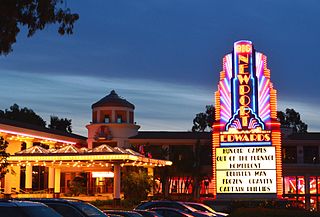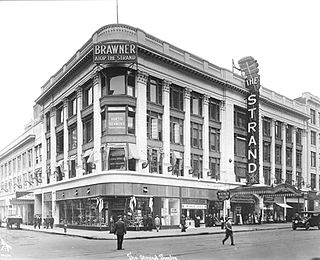
A movie theater or cinema ,also known as a movie house, cinema hall, picture house, picture theater, the pictures, or simply theater, is a business that contains auditoriums for viewing films for public entertainment. Most are commercial operations catering to the general public, who attend by purchasing tickets.

Cinerama is a widescreen process that originally projected images simultaneously from three synchronized 35mm projectors onto a huge, deeply curved screen, subtending 146-degrees of arc. The trademarked process was marketed by the Cinerama corporation. It was the first of several novel processes introduced during the 1950s when the movie industry was reacting to competition from television. Cinerama was presented to the public as a theatrical event, with reserved seating and printed programs, and audience members often dressed in their best attire for the evening.

The Cinerama Dome is a movie theater located at 6360 Sunset Boulevard in Hollywood, California. Designed to exhibit widescreen Cinerama films, it opened November 7, 1963. The original developer was William R. Forman, founder of Pacific Theatres. The Cinerama Dome continued as a leading first-run theater, most recently as part of the ArcLight Hollywood complex, until it closed temporarily in March 2020 due to the COVID-19 pandemic in California. The ArcLight chain closed permanently in April 2021, with the theater never having reopened. In June 2022, it was announced that there were plans to reopen it and the former ArcLight Hollywood under a new name, Cinerama Hollywood.

AMC Entertainment Holdings, Inc. is an American movie theater chain founded in Kansas City, Missouri, and now headquartered in Leawood, Kansas. It is the largest movie theater chain in the world. Founded in 1920, AMC has the largest share of the U.S. theater market ahead of Regal Cinemas and Cinemark Theatres.

Todd-AO is an American post-production company founded in 1953 by Mike Todd and Robert Naify, providing sound-related services to the motion picture and television industries. The company retains one facility, in the Los Angeles area.

Edwards Theatres is an American movie theater brand owned and operated as an in-name-only unit of Cineworld through its Regal Cinemas chain. Originally founded in 1930 by William James Edwards Jr., it operated independently as a major theater chain in the Southern California region until it was consolidated with Regal Cinemas and United Artists Theatres into the Regal Entertainment Group (REG) in 2002. Although REG took over all Edwards operations, many theaters in Southern California still bear the Edwards name for marketing purposes.

Rave Cinemas, formerly known as "Rave Motion Pictures", is a movie theater brand founded in 1999 and owned by Cinemark Theatres. It previously was headed by Thomas W. Stephenson, Jr., former CEO of Hollywood Theaters, and Rolando B. Rodriguez, former Vice President and Regional General Manager for Walmart in Illinois and northern Indiana. The chain was headquartered in Dallas, Texas until it was acquired by Plano-based Cinemark Theatres.

Carmike Cinemas, Inc. was an American motion picture exhibitor headquartered in Columbus, Georgia. As of March 2016, the company had 276 theaters with 2,954 screens in 41 states, and was the fourth largest movie theater chain in the United States. The company billed itself as "America's Hometown Theatre" and Carmike theaters were largely positioned in rural or suburban areas with populations under 200,000. The company's theaters operated under various names and generally had a name followed by the number of auditoriums at that location; for example, "Carmike 15".
The Indian Hills Theater in Omaha, Nebraska, United States, was a movie theater built in 1962 showcasing films in the Cinerama wide-screen format. Its location was at 8601 West Dodge Rd. The theater's screen was the largest of its type in the United States. Despite the protests of local citizens, Hollywood legends, and the National Trust for Historic Preservation, the theater was demolished in 2001 by Nebraska Methodist Health System for a parking lot.

The Hollywood Theatre is a historic movie theater in northeast Portland, Oregon built in 1926. It is a central historical landmark of the Hollywood District, which is named after the theatre itself. The theatre is located at 4122 NE Sandy Blvd, and is operated by a non-profit organization. The Hollywood Theatre was placed on the National Register of Historic Places in 1983 and is considered to be a gem of Northeast Portland's historic culture and tradition. It is the only theater in Oregon showing movies in 70mm film.

The Seattle Cinerama Theatre is a landmark movie theater in the Belltown neighborhood of Seattle, Washington, United States. The theater opened in 1963 and was renovated in the 1990s after its acquisition by Paul Allen. The Cinerama was closed in May 2020. At the time of its 2020 closure, it was one of only three movie theaters in the world capable of showing three-panel Cinerama films. In 2023, the theater was purchased by the Seattle International Film Festival (SIFF) and reopened on December 14, 2023 as SIFF Cinema Downtown due to trademark issues with the "Cinerama" name.

4D film is a presentation system combining motion pictures with synchronized physical effects that occur in the theater. Effects simulated in 4D films include motion, vibration, scent, rain, mist, bubbles, fog, smoke, wind, temperature changes, and strobe lights. Seats in 4D venues vibrate and move.

The Somerville Theatre is an independent movie theater and concert venue in the Davis Square neighborhood of Somerville, Massachusetts, United States. Over one hundred years old, the Somerville Theatre started off as a vaudeville house and movie theater. The theater has since transitioned and now operates as a live music venue and first-run movie theater. As a music venue, the theater has played host to many historic concerts, including the first of the two Last Dispatch concerts, two shows by Bruce Springsteen in 2003, and a performance by U2 in 2009. Recent live performances have included Ryan Adams & the Cardinals, Cursive, Norah Jones, The Jonas Brothers, Joan Baez, and the John Butler Trio.
ArcLight Cinemas was an American movie theater chain that operated from 2002 to 2021. It was owned by The Decurion Corporation, which was also the parent company of Pacific Theatres. The ArcLight chain opened in 2002 as a single theater, the ArcLight Hollywood in Hollywood, Los Angeles, and later expanded to eleven locations in California, Massachusetts, Maryland, and Illinois.
Richard Layton Crowther,, was an architect and author who achieved international renown for his progressive holistic compositions, particularly his pioneering designs employing passive solar energy.
The Cooper Foundation of Lincoln, Nebraska, is a charitable and educational organization that supports nonprofit organizations in Lincoln and Lancaster County, Nebraska.
In 1969, Robert Redford purchased 6,000 acres (24 km2) at the base of 12,000-foot (3,700 m) Mount Timpanogos in Utah's Wasatch Mountains. He named this land Sundance. The Sundance Group is a listing of all the businesses that run under the Sundance corporate umbrella started by and run by actor Robert Redford.

The Strand Theatre was an early movie palace located at 1579 Broadway, at the northwest corner of 47th Street and Broadway in Times Square, New York City. Opened in 1914, the theater was later known as the Mark Strand Theatre, the Warner Theatre, and the Cinerama Theatre. It closed as the RKO Warner Twin Theatre, and was demolished in 1987.

Megaplex Theatres is a cinema chain based in Sandy, Utah. It was founded in 1999 by the late Larry H. Miller, who was then the owner of the Utah Jazz; currently it is owned by the Larry H. Miller Company. As of 2023, Megaplex Theatres operates 15 locations in Utah and Nevada, and it has plans to expand into Idaho.

The Nimoy Theater, formerly known as Crest, Majestic Crest and Bigfoot Crest Theatre, is a movie theatre located in the Westwood neighborhood of Los Angeles, California. It was founded as the UCLAN in 1941, and was built for live performances but switched to a newsreel cinema during World War II. Through ownership changes, it has been known at various times as UCLAN Theatre, Crest Theatre, and Metro Theatre. The original 500-seat art deco style theater was designed by Arthur W. Hawes.

















